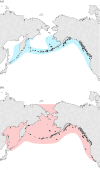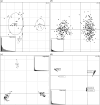Revised taxonomy of eastern North Pacific killer whales (Orcinus orca): Bigg's and resident ecotypes deserve species status
- PMID: 38545612
- PMCID: PMC10966402
- DOI: 10.1098/rsos.231368
Revised taxonomy of eastern North Pacific killer whales (Orcinus orca): Bigg's and resident ecotypes deserve species status
Abstract
Killer whales (Orcinus orca) are currently recognized as a single ecologically and morphologically diverse, globally distributed species. Multiple morphotypes or ecotypes have been described, often associated with feeding specialization, and several studies have suggested taxonomic revision to include multiple subspecies or species in the genus. We review the ecological, morphological and genetic data for the well-studied 'resident' and Bigg's (aka 'transient') ecotypes in the eastern North Pacific and use quantitative taxonomic guidelines and standards to determine whether the taxonomic status of these killer whale ecotypes should be revised. Our review and new analyses indicate that species-level status is justified in both cases, and we conclude that eastern North Pacific Bigg's killer whales should be recognized as Orcinus rectipinnus (Cope in Scammon, 1869) and resident killer whales should be recognized as Orcinus ater (Cope in Scammon, 1869).
Keywords: Cetacea; odontocete; speciation.
© 2024 The Authors.
Conflict of interest statement
We declare we have no competing interests.
Figures








References
-
- Forney KA, Wade PR. 2006. Worldwide distribution and abundance of killer whales. In Whales, whaling and ocean ecosystems (eds Estes JA, DeMaster DP, Doak DF, Williams TM, Brownell RL), pp. 145–162, University of California Press.
-
- Perrin WF. 2006. Review of the nomenclature of killer whales. NOAA Administrative Report NMFS-SWFSC. LJ-06-01.
-
- Heyning JE, Dahlheim ME. 1988. Orcinus orca. Mamm. Species. 304 , 1–9. ( 10.2307/3504225) - DOI
-
- Hershkovitz P. 1966. Catalog of living whales. Bull. U.S. Natl. Mus. 246 , 1–259. ( 10.5479/si.03629236.246) - DOI
-
- Committee on Taxonomy . 2022. List of marine mammal species and subspecies. See www.marinemammalscience.org (accessed 19 December 2022)
Associated data
LinkOut - more resources
Full Text Sources

